| dc.contributor.author | Gullo, Paride | |
| dc.contributor.author | Tsamos, Konstantinos | |
| dc.contributor.author | Hafner, Armin | |
| dc.contributor.author | Banasiak, Krzysztof | |
| dc.contributor.author | Ge, Yunting | |
| dc.contributor.author | Tassou, Savvas A. | |
| dc.date.accessioned | 2018-09-04T08:33:46Z | |
| dc.date.available | 2018-09-04T08:33:46Z | |
| dc.date.created | 2018-09-03T09:14:16Z | |
| dc.date.issued | 2018 | |
| dc.identifier.issn | 0360-5442 | |
| dc.identifier.uri | http://hdl.handle.net/11250/2560614 | |
| dc.description.abstract | The ever-stricter regulations put into effect worldwide to significantly decrease the considerable carbon footprint of commercial refrigeration sector have forced the transition to eco-friendlier working fluids (e.g. CO2, R290, R1234ze(E), R450A, R513A). However, the identification of the most suitable long-term refrigerant is still today's major challenge for supermarkets located in high ambient temperature countries, especially as their air conditioning (AC) need is considered. The results of this theoretical study revealed that multi-ejector “CO2 only” systems can outperform R404A-, R290-, R1234ze(E)-, R134a-, R450A- and R513A-based solutions in an average-size supermarket located in various cities below the so-called “CO2 equator”. In fact, energy savings as well as reductions in environmental impact respectively up to 26.9% and 90.9% were estimated over conventional hydrofluorocarbon (HFC)-based solutions for the scenario including the AC demand. Also, the solution using multi-ejector block (in non-optimized operating conditions) enabled reducing the power input up to 50.3% over HFC-based units at outdoor temperatures from −10 °C to 5 °C. Finally, the study demonstrated that transcritical CO2 multi-ejector systems integrated with the AC unit allow potentially pushing the “CO2 equator” further South than Northern Africa. © 2018 Elsevier Ltd. All rights reserved. | nb_NO |
| dc.language.iso | eng | nb_NO |
| dc.publisher | Elsevier | nb_NO |
| dc.rights | Attribution-NonCommercial-NoDerivatives 4.0 Internasjonal | * |
| dc.rights.uri | http://creativecommons.org/licenses/by-nc-nd/4.0/deed.no | * |
| dc.title | Crossing CO2 equator with the aid of multi-ejector concept: A comprehensive energy and environmental comparative study | nb_NO |
| dc.type | Journal article | nb_NO |
| dc.type | Peer reviewed | nb_NO |
| dc.description.version | acceptedVersion | nb_NO |
| dc.source.journal | Energy | nb_NO |
| dc.identifier.doi | 10.1016/j.energy.2018.08.205 | |
| dc.identifier.cristin | 1606123 | |
| dc.description.localcode | © 2018. This is the authors’ accepted and refereed manuscript to the article. Locked until 1.9.2020 due to copyright restrictions. This manuscript version is made available under the CC-BY-NC-ND 4.0 license http://creativecommons.org/licenses/by-nc-nd/4.0/ | nb_NO |
| cristin.unitcode | 194,64,25,0 | |
| cristin.unitname | Institutt for energi- og prosessteknikk | |
| cristin.ispublished | true | |
| cristin.fulltext | postprint | |
| cristin.qualitycode | 2 | |

